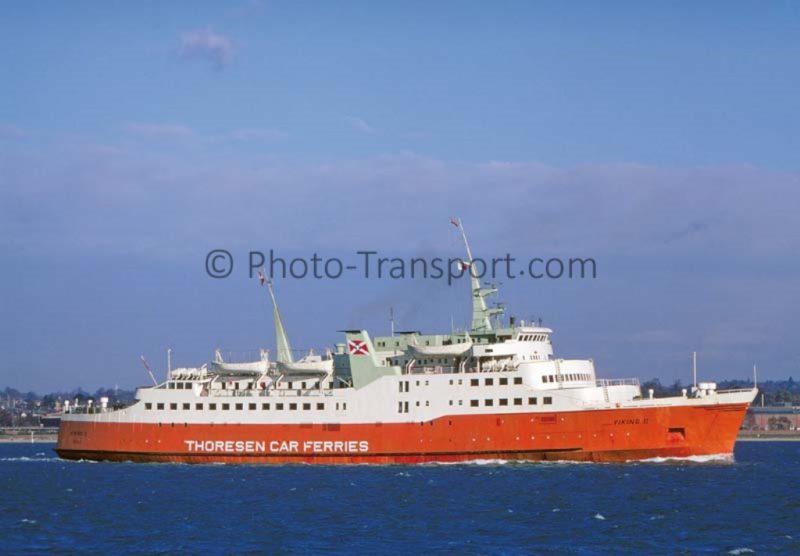
What did Richard Branson and Otto Thoresen have in common? It certainly wasn’t a mane of hair (at the time Otto was virtually bald) or the beard (the Norwegian was, to my knowledge, always clean shaven). What links these two transport entrepreneurs was a common epiphany, that when faced with yet another mediocre journey on what they considered to be an over-priced, substandard rival, they decided to enter the fray with their own revolutionary products. For Branson it was Virgin Atlantic Airways which first flew to the USA in 1984. Twenty years earlier Thoresen Car Ferries was born.
Otto Thoresen had worked for a number of years as manager of Fred. Olsen’s Mediterranean operation, garnering experience in the freight and ferry business. During that time he had become increasingly frustrated at the amount of inactive time ships under his tenure spent between voyages and the time-consuming, arcane freight handling methods employed at each port. He was convinced that he c, utilising a roll-on roll-off freight containerisation system. He also felt that this could operate in tandem with a more streamlined method of transporting passengers and cars.
The epiphany referred to above came on a bleak winter crossing sometime in the late 1950s. Having been diverted from Dunkirk and soldiering on despite a heavy cold (which prevented him from flying), Thoresen and his wife embarked on one of the ageing ‘mail steamers’ at Dieppe, possibly the Brighton. Feeling unwell and delayed for his meeting in London, Thoresen was not a happy man. He is quoted in Miles Cowsill and John Hendy‘s book Remembering the Thoresen Vikings, as saying ‘We were served an indifferent breakfast on a tablecloth full of tea-spots. My wife tells me that I banged my fist on the table and said “You needn’t be a genius to do better than this”.’ Possibly not but it did require foresight, perseverance, considerable investment and an element of good fortune.
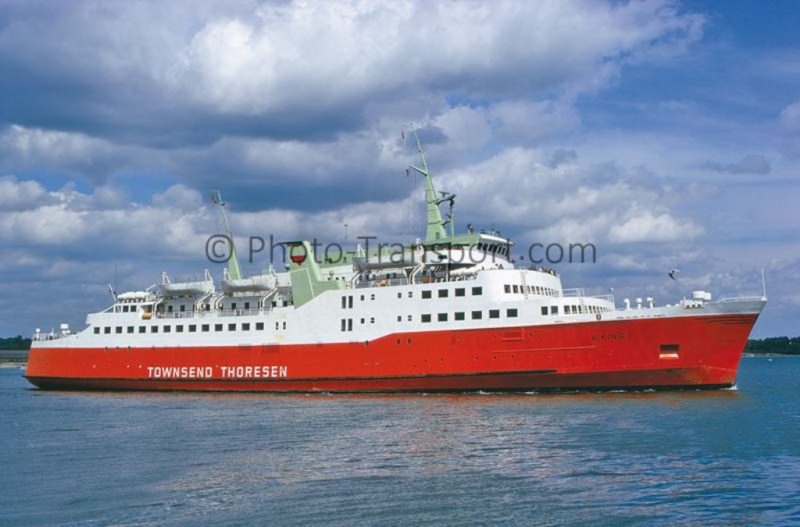
Thoresen knew that the success of his idea required a high frequency, mass movement route. The English Channel was the obvious choice but had been monopolised by the British and French railway companies for over a century, government purse strings and ‘public service’ considerations almost certainly stifling innovation. Nevertheless by the turn of the decade the rail companies were introducing new vessels with modern interiors, such as the Maid of Kent, but also reviewing their position and concentrating this new tonnage on their most profitable Dover Straits services. Thoresen correctly guessed that with increased private car ownership, the travelling public might also want Western Channel services that avoided the (pre-M25) London bottleneck. Jung’s theory of ‘synchronicity’ now played its part, meaningful coincidences evolving to fulfil the Norwegian’s plan.
British Railways (BR) shifted their Channel Island services to Weymouth, whilst further cutbacks to their loss making Le Havre overnight service in 1958 were a further clear indication of retrenchment. Thoresen decided to strike and enlisted the crucial assistance of London shipbrokers James Burness & Sons Ltd., who began to sound out Southampton, Weymouth and Cherbourg about a proposed cross-channel car ferry service. Cherbourg had long been bypassed in favour of Le Havre (for Paris) and to a lesser extent St. Malo (for Brittany) as a ferry port on the French side of the Channel. With its historic role as a staging post for transatlantic liners also under threat the local authorities were very receptive to the proposed new service. On the English side, Southampton was still smarting from BR’s decision to reposition its Channel Island service to Weymouth (in May 1961 the Isle of Guernsey made the final passenger ferry crossing from the Hampshire port to the islands) and persistent rumours that it would soon pull out of the Le Havre route altogether. For its part Weymouth’s star was on the rise having secured the Channel Island traffic.
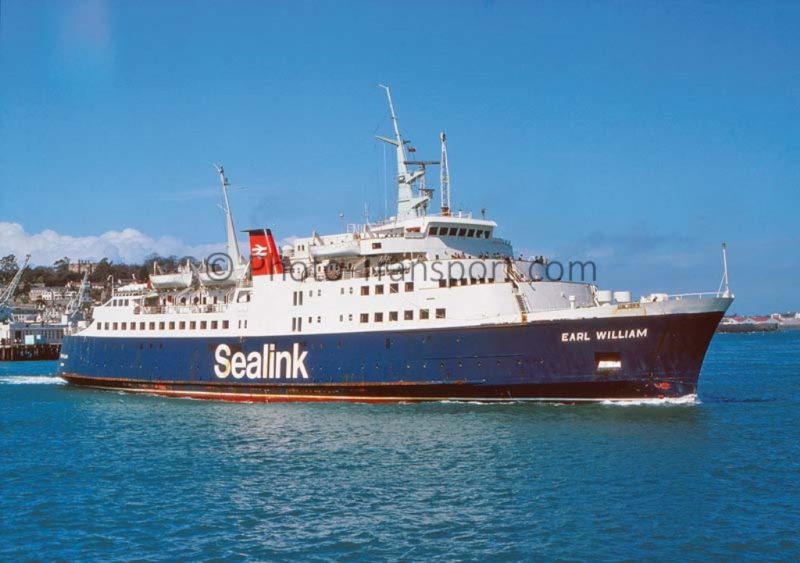
So it was that the various parties came together and in January 1963 it was made public that a Norwegian group, with British and French investors, were planning the new service from Southampton to Cherbourg. Southampton had been selected over its Dorset rival on the basis of guaranteeing provision of the necessary facilities by the 1964 inception date. Ironically they intended to use the berth vacated by the Channel Island ferries. Seeds had been sown.
With agreements for the development of port facilities now in place, all the ‘Southampton-Cherbourg Car Ferry Service’ of Otto Thoresen Shipping Co. A/S needed was a ship. In April 1963 it was announced that shipyards throughout Europe had been invited to tender for the first vessel and on the 15th of the month a communiqué confirmed that Kaldnes Mek Verksted A/S, at Tonsberg in Norway, had been selected, based on price, delivery date and credit provision considerations. The actual cost would be £1.2 million, £300,000 less than initially projected. In order to design the new vessel Thoresen turned to the most prolific, cutting edge, ferry design company in the world, Knud E Hansen A/S (KEH) of Denmark.
In the early 1960s the KEH drawing office was a hotbed of creativity, where three eminent naval architects of very diverse personalities. Tage Wandborg, Dag Rogne and Poul Erik Rasmussen were particularly prominent. Whilst Rasmussen concentrated on the underwater elements, Wandborg and Rogne were engaged in an increasingly competitive battle, especially from Wandborg’s viewpoint, over how best to develop the hull and upper works. Wandborg, a flamboyant extrovert was and remained a great aesthete for whom balance and beauty were as significant as practicality. He would spend considerable time developing and refining a ship’s look, including the livery. In contrast Rogne, more quiet and reserved by nature, was a pragmatist, believing that the designer’s role was to interpret the client’s requirements and meet these stipulations in the shortest possible time and at the least possible cost. In the late 1950s a fusion of their philosophies created a general design that would dominate the ferry industry over the forthcoming decade and beyond. It was first manifested in Juelsminde-Kalundborg Linien’s 2,301 grt Julie and Kalle of 1962 and 1963. These twins provided a blueprint for Thoresen Shipping’s new order.
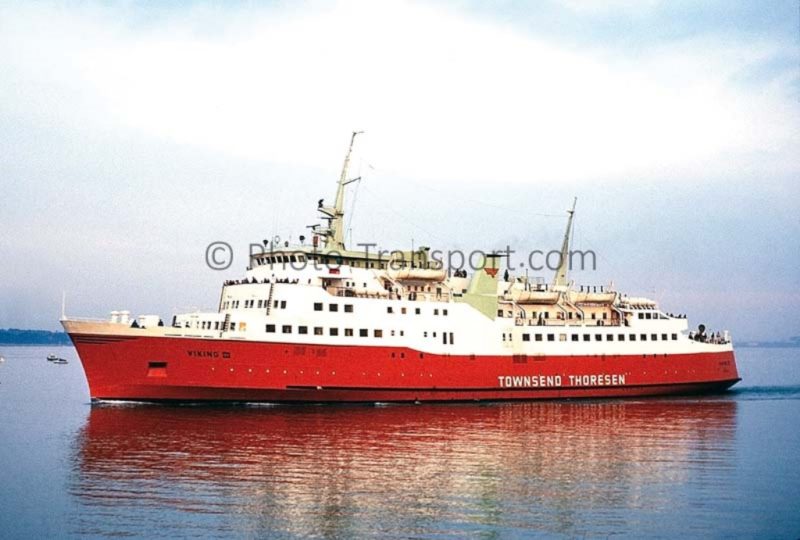
Once the design was finalised further details of both the intended service and the ships (plural) emerged. On the strength of early bookings and confirmation of BR’s withdrawal from the Le Havre service, Thoresen had placed an order for a second, identical sister ship on 19th September 1963. Six days later shareholders were appraised of the specifications of the ships, how they were to be funded (an 80% credit had been arranged repayable over eight years) and a timetable. In November 1963 it emerged that the new ferry terminals at Southampton and Cherbourg were already under construction and the first ship was due to be delivered on 2nd April 1964, inaugurating the service on 11th May.
The pace of construction was impressive. Having laid the keel in October 1963 Viking I was launched by Mrs. Thoresen into the icy waters of Oslofjord just four and a half months later, on 31st January 1964. In fact the name had to be formally amended to ’Car ferry Viking I’ on instruction from the Norwegian Shipping authorities. It transpired there was already a Viking I on the national register. Later than initially predicted she was finally delivered on 29th April 1964, the following day Viking II was launched. Well aware of the publicity value Thoresen had construed a special naming ceremony, involving not one but three ’Godmothers’. Selected by their respective cities, students Kay Hollingsworth (Southampton), Francoise Ninn (Cherbourg) and Marie Helene Grosos (Le Havre) not only named the ship but also attended a lunch and party on board Viking I before joining that ship’s delivery voyage to Cherbourg, where she arrived on Saturday 2nd May. The following morning she moored alongside berth number 7 at Southampton, part of the £200,000 redevelopment of the port’s Outer Dock.
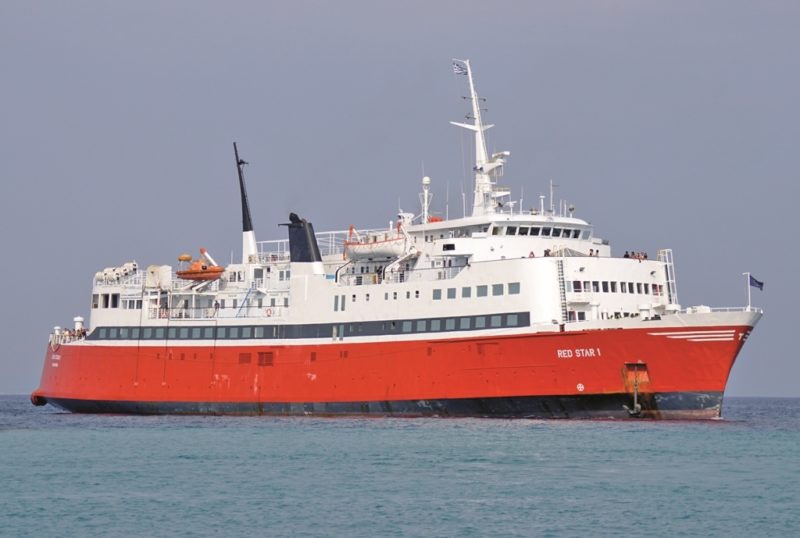
The new ferry caused a sensation. Not only was she the first vessel on the English Channel to feature bow and stern loading doors, thereby introducing the Roll-on Roll-off concept to the market but Wandborg’s styling gave her a stylish, modern profile, radically different from the ‘mini-liner‘ look of contemporary BR ferries. Emphasising just how different this new project was the ship also introduced the company’s visually startling livery. Publicised as a safety feature the orange hull, white lower superstructure and green upper works, funnel and masts was a stark contrast to the staid railway steamers. Adding the company name along each flank was similarly inspired. Of course the new look wasn’t universally admired and traditionalists considered it all rather gaudy, but safety feature or not it certainly set the new ferries and service apart. Wandborg’s touch was evident everywhere, including the swept back stacks on each flank capped by extended fins, which in tandem with the raked masts and neatly tiered decks conveyed a sense of speed and modernity.
At 3,671 grt, with a length overall of 99.50m (326ft 5in) and a beam of 18.32m (76ft 1in) she was the largest KEH ferry designed to date. In order to aid stability there was extensive use of aluminium, including the upper deckhouse and masts. Viking I and her two subsequent sisters were powered by a pair of oil fired Pielstick 12 cylinder engines, built by the Swedish company AB Lindholmens at Varv Gothenburg. Generating 10,200 bhp these achieved 20.5 knots on trials, a full knot faster than specified in the contract and easily capable of providing an 18.5 knot service speed. Perhaps even more impressively the ship could be taken from full-speed to stationery in barely over a minute and within three ship lengths. Auxiliary machinery included a powerful 600hp bow thruster that provided six tons of lateral thrust to manoeuvre on and off the link spans at Southampton and Cherbourg. The hull was especially ice strengthened with a view to potential winter charters in the Baltic.
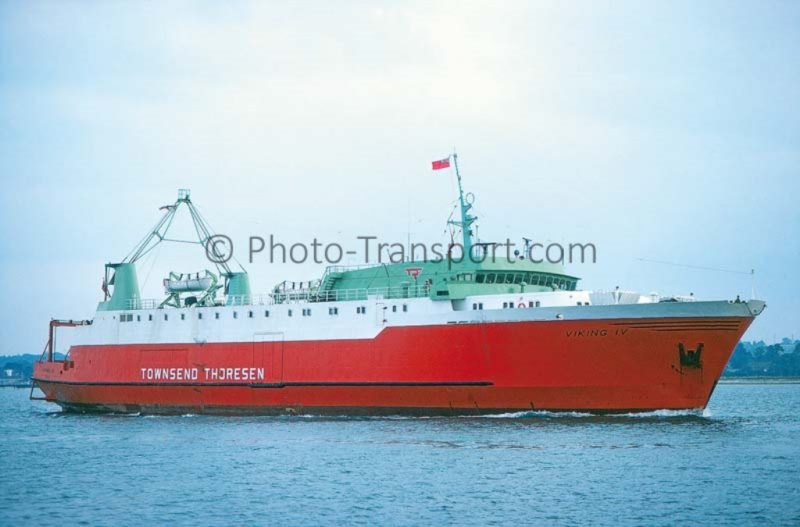
As previously mentioned Viking I was the first Ro-Ro vessel on the English Channel, with vehicles being driven on via a stern ramp in Southampton and off via a forward ramp in Cherbourg. The ramp was concealed behind the forward bow door which was hinged at the top and raised hydraulically. For the return journey the pattern was reversed. Although there was only a single vehicle access lane on the link span and ramp, the main car deck offered a broad spread of eleven lanes, made possible by the exhausts running up each flank. Augmenting the main deck were versatile hinged platforms which could carry up to 50 cars once raised, or be tucked away flush with the hull sides when the lower lanes were carrying commercial vehicles. Speed was of the essence when it came to loading and unloading the ferry and it was estimated that the entire complement of 180 cars could be unloaded in just 13 minutes. To Otto Thoresen’s doubtless delight it would be possible to turn the ships around in just one hour.
One of the company’s main goals was to provide a fresh alternative to the rather tired, conservative accommodation offered by the incumbent railway ships. Utilising light and bright veneers, vibrant fabrics and modern synthetic materials, the passenger spaces on Viking I introduced paired back, clean Scandinavian style to the English and continental travelling public. It proved enduringly popular.
There were three passenger decks above the vehicle space with the full length Promenade Deck the most prominent. Furthest forward was the 190 seat saloon, incorporating ‘The Smuggler’s Cave Bar’ and the ‘Smorgasbord’ Buffet’ during summer daytime crossings, where it was possible to eat as much as one liked for 15 shillings. This exotic touch of Scandinavian cuisine proved very popular and a source of many family and group competitive eating contests. Aft of the saloon was a large central lobby, housing the main staircases and access to the two passenger lifts on each beam. This was also the embarkation point for foot passengers, with shell doors for gangway access and included shops and toilet facilities. Directly aft of the lobby, on each flank, were the main lounges offering seating and ’sleeperette’ recliners for just shy of 180 passengers. Down the centre line were two banks of four berth cabins, with other cabin accommodation being situated in the forward portion of ’tween deck space below the main vehicle deck. Aft on Promenade Deck was a forty seat lounge area with aft facing windows. From here doors opened onto a small open passenger space adjacent to the cordoned off mooring deck.
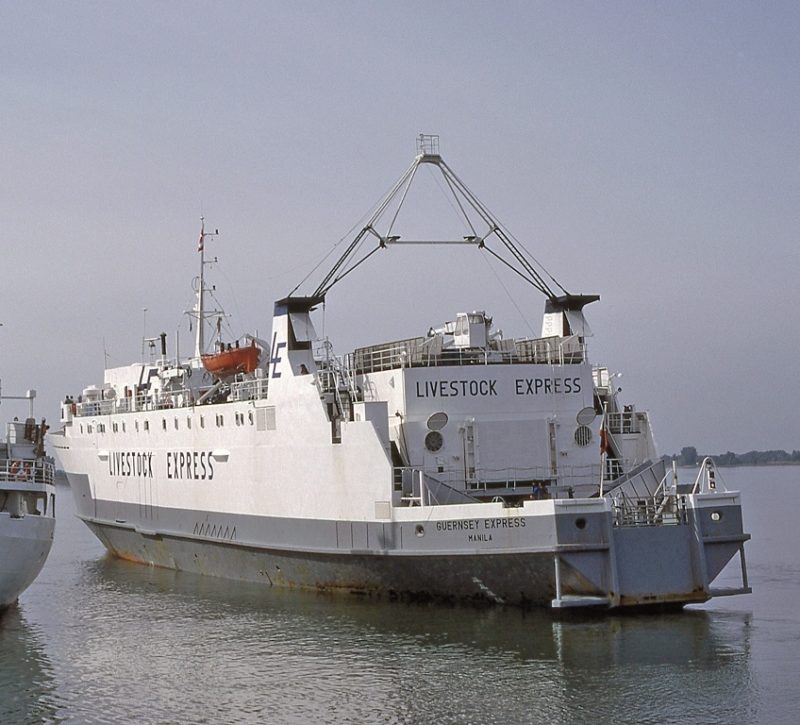
If we return to the lobby and head up the forward facing main flight of stairs to Boat Deck, passengers encountered another hallway, offset to starboard. Straight ahead, with 180 degree views out over the bow and each side was the popular cafeteria, whilst aft to starboard was ’Le Commandant’ à la carte restaurant. The accompanying galley, crew and officer messes were positioned on the port side. From the hallway, outer deck space was accessed via a door on the starboard side. Heading aft from here was an outdoor promenade under two lifeboats leading to a sheltered sun deck. With glazed panels cut into the rear bulwark allowing seated passengers views of the wake beyond, it was a pleasant spot to while away the hours, weather permitting. Heading around to the portside flank was more promenade deck space located under a further pair of lifeboats. At the point where the funnel casings rose up were steps on each side rising to the forward outer deck space on what was confusingly named Bridge Deck. Common at the time, the outdoor promenade on Bridge Deck flanks continued forward, under a single lifeboat to a forward facing observation vantage point, which was particularly popular for port arrivals and departures. The walkway surrounded the Captain, Chief engineer and officers’ quarters and extended aft via a narrow causeway to the expansive sun deck. This was a favourite sheltered place for passengers on balmy summer crossings, the company’s promotional film showed it crammed with snoozing passengers, relaxing and sunbathing in vibrant hued, striped deck chairs. A short flight of stairs on each side of Bridge Deck gave access to the rather more appropriately named ‘Upper Bridge Deck’. With the wheelhouse, chart and communications rooms this was the summit of the ship, flanked by the bridge wings and topped only by the raked radar mast.
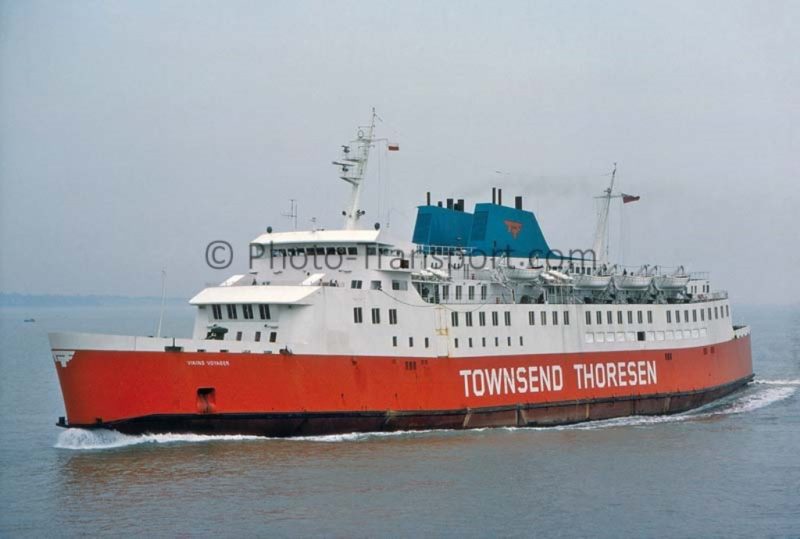
Three ‘practice runs’ were undertaken, starting on 4th May 1964, in which seventy cars and drivers armed with full documentation passed through the full embarkation process, from checking in to driving on board. The trial also tested the new 130ft long links pan and its 10ft wide traffic lane. On 5th and 6th May the press were taken on cruises in the Solent and to Cherbourg respectively, returning with nothing but praise about the ship and the company. If it all seemed too good to be true, teething gremlins were unfortunately about to strike. The port engine was found to be running dangerously hot on the return from France, delaying the arrival back in Southampton. Swedish engineers tried but failed to rectify the fault until spare parts could be sourced and supplied, necessitating a postponement of the revised maiden sailing (7th May) until its original advertised date. Under leaden skies and with crewmen sprucing up the paintwork there was a ceremonial opening of the linkspan by the Mayor of Southampton on 11th May 1964, before one hundred and seventy cars drove on board. The flag-bedecked Viking I eased away from her berth at 1030 for a maiden five hour crossing to Cherbourg.
Viking I quickly gained an excellent reputation. Like so many ships the amenities and décor might have been impressive and the lower prices a definite incentive but it was the crew that really helped to make the difference. It’s an undoubted generalisation but their enthusiasm and good cheer made a refreshing change. Perhaps remembering that initial epiphany Thoresen lent great weight to keeping his crews and shore side staff content and an example of the company’s egalitarian approach was when management periodically served tables in the crew mess. The contrast between Thoresen and BR passenger and vehicle numbers was remarkable. Within three weeks the new venture had carried more cars than their predecessors had in the whole of 1962 (3,500 compared to 2,642). Passenger numbers were equally impressive with 13,000 making the crossing in less than a month.
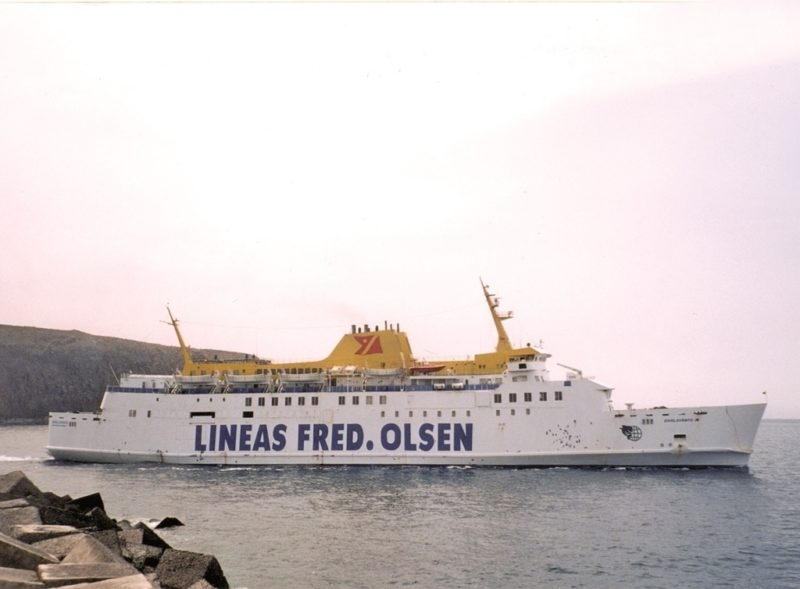
Largely unheralded Viking II entered service with a 19th July 1964 sailing to Cherbourg, allowing Viking I to inaugurate the Le Havre service the following day. That same month an order was placed for a third ship, the successful tender going to Orenstein-Koppel und Lubecker Masch A/G in West Germany. Barely two months after starting the service and with very healthy forward bookings Thoresen felt the third ship would consolidate their position in light of increasing demand and provide greater flexibility in terms of routes and timetables.
The first two ships were structurally identical, the only differences being a smaller pair of radar scanners on Viking I’s forward mast (she would subsequently have a larger unit installed above the bridge) and a short mast on the second ship’s f’c’sle. Early on it was easy to differentiate the sisters by their hull livery, initially there was a much deeper mid-ships ‘drop’ in the orange hull of Viking I. Viking II’s less significant differential gave the ship a more harmonious appearance and the same scheme was therefore adopted by Viking I at the first dry-docking.
Although there was one early mishap when Viking I dealt a glancing blow to BR’s Elk whilst leaving Outer Dock on 7th September 1964 and sustained slight damage, the new services settled into a happily unremarkable rhythm. Early daily Cherbourg sailings departing Southampton at 1030 and returning from France at 1630 were supplemented by overnight sailings from 15th May through into July. Departures from Southampton at 2230 on Monday, Wednesday, Friday and Saturdays and Cherbourg at the same time on Tuesday, Thursday and Sunday necessitated a subsequent shift of the 1030 and 1630 day sailings between the two ports on each subsequent day. Confusing? Yes, it most certainly was.

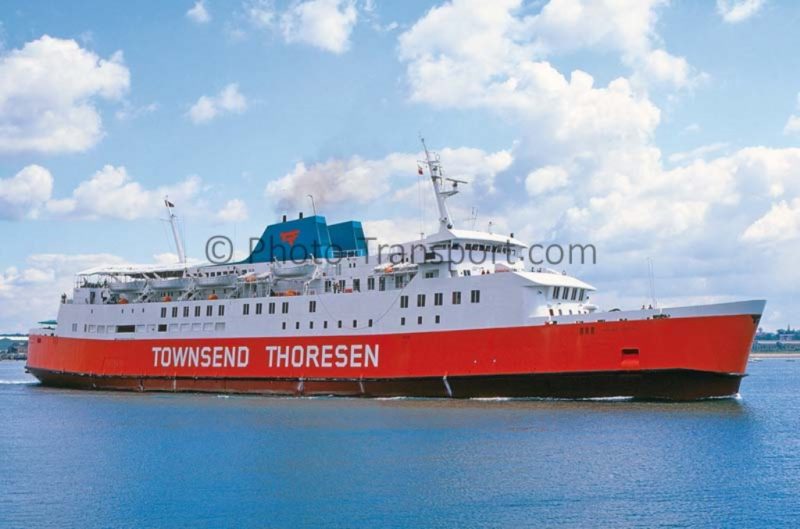
A more straightforward ’peak season’ timetable was introduced from 20th July through to 27th September 1964, with the introduction of Viking II allowing daily departures from Southampton at 1030 and 1630 and corresponding sailings from Cherbourg at 1630 and 2230. A single daily Le Havre sailing left England at 2230 each evening and returned from the mouth of the Seine at 0930 the following day. At the end of that first, highly successful summer season Thoresen dispensed with the services of James Burness & Sons Ltd. and took over complete control of the ships and their services. Seeking to increase its profile amongst the UK travelling public they planned a quite unique publicity exercise, to run in conjunction with a concerted TV and newspaper advertising campaign. Initially earmarked for Viking I (eventually Viking II was used) the company decided to send the ferry on a 1,100 mile tour of the UK, concentrating on the regional market, away from the South East. Starting at Liverpool (27th-28th October), where over 10,000 members of the public came aboard at the Pier Head, in the shadow of the Liver building, the ferry sailed south under the watchful eye of Captain Gaiever, to Avonmouth (29th-30th October) and Southampton (31st October to 1st November), then up the east coast to Hull (3rd-4th November) and Newcastle (6th-7th November) culminating at Leith (9th-10th November). Harnessing the creativity within the marketing team, Viking II’s car deck was transformed into a mix of film-set and dance venue. A special dance floor was laid over the utilitarian steel car lanes whilst bulkheads were adorned with suitable props from the recently completed ’The Long Ships’ movie, starring Sidney Poitier and Richard Widmark. The piéce de rèsistance and focal point for all the festivities was a 19ft long boat replica from the film, serving as a fitting backdrop for the ‘Grand Nordic Balls‘, charity events held nightly in port and featuring celebrated bands such as Acker Bilk. A silver model of the long ship was presented by the Captain to dignitaries at each venue. As a goodwill, flag-waving publicity exercise the tour proved highly successful.

Business blossomed even more rapidly than Thoresen could have predicted, however it was an intrinsically seasonal service and therefore securing winter charters was an important consideration from the start. The company had investigated repositioning at least one ferry to the Southern Hemisphere, which made eminent good sense given the opposite summer seasons. The La Plata crossing from Buenos Aires to Montevideo was a similar duration to the cross-channel service but tentative plans were ultimately thwarted by the deteriorating political situation in Argentina. Charters were therefore sought closer to home and with only a single ship required to fulfil the winter timetable Viking II commenced a two month charter on the Atlantic Steam Navigation Co.’s Tilbury-Antwerp service in February 1965, following its tour of Britain, a contract fulfilled in the following two winters by Viking I. Whilst Viking II was plying back and forth to Belgium her younger sister Viking III was preparing to be named by a director’s wife, Mrs. Roald Auckner. The ceremony took place at Lubeck on 10th March 1965, after which the almost structurally complete skeleton of the ship was taken to the fitting out berth to be readied for her 25th June maiden sailing.
As with the first ship there were last ditch complications, although this time it was the starboard engine that was to blame. On trials off Lubeck it was discovered that the engine and shaft were out of kilter and the ensuing realignment delayed the acceptance of the ship and her delivery voyage by a full week until 23rd June. That evening she finally departed the builder and headed south west, only to encounter unseasonably torrid weather in the North Sea which further delayed her arrival at Southampton. Although already running some two hours late, thanks to the efficiency and dedication of the crew, company, port and agents staff she was stored, loaded and sailed on her maiden crossing just ninety minutes later, with Captain Giaever once more presiding on the bridge.
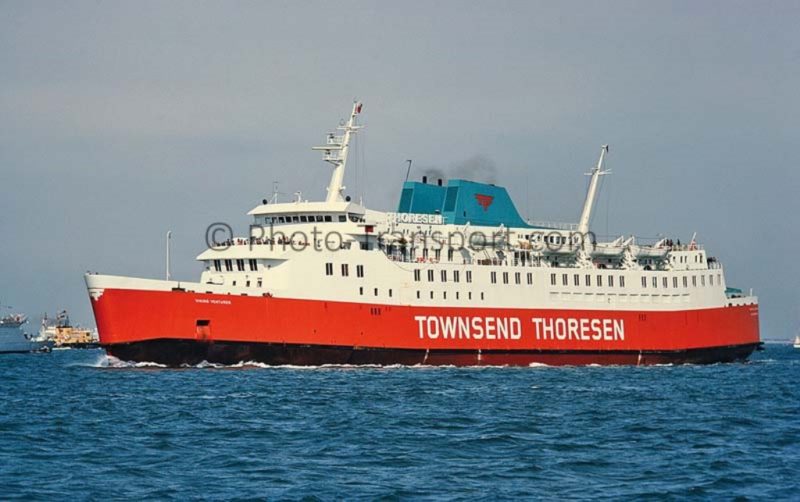
At the end of the 1965 season a new, experimental, winter triangular service was timetabled, with Sunday night sailings from Southampton to Le Havre and Cherbourg from where the ferry returned to her home port for Monday evening. Having proved unsuccessful a more straightforward six times weekly Le Havre service was introduced the following winter, Viking II undertaking the task whilst Viking III started the first of what became an annual eight month charter to Lion Ferry for their Harwich-Bremerhaven route. Cherbourg was dropped as an ‘off-season’ destination entirely.
Thoresen’s success, particularly on the Le Havre service, inevitably spiked the interest of competitors and it wasn’t long before the orange hulled Vikings were sharing the sea lanes with a joint British and French operation known as Normandy Ferries. With its freight business under threat P&O’s General Steam Navigation Company (GSNC) joined forces with the Société Anonyme de Gerance et d’Armenent (SAGA), introducing the elegant Nantes built Dragon and Leopard in 1967 and 1968 respectively.
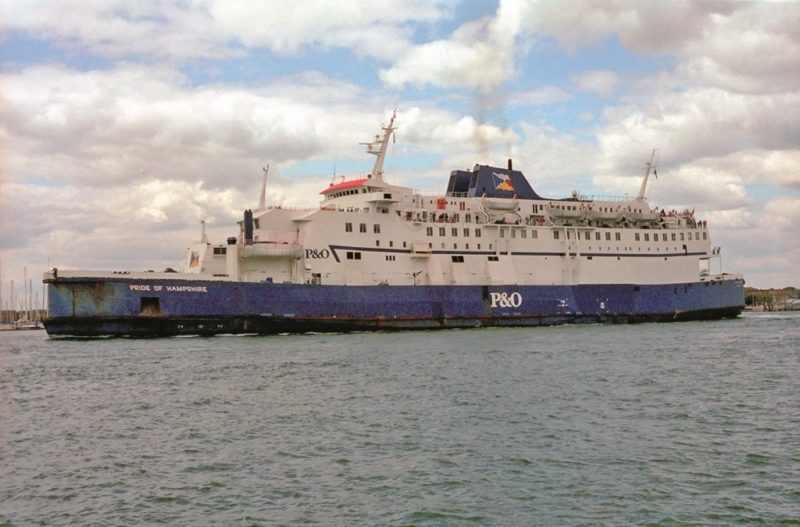
1968 would prove a pivotal year for all three Viking ships and indeed the company itself. Although a relative newcomer to the scene Thoresen was one of only two privately owned channel ferry operators. The other company enjoyed a much longer heritage, having pioneered a car ferry service across the Channel forty years previously. Captain Stuart Townsend was a fascinating character who synthesised his passion for cars with the family shipping business to introduce the first regular car and passenger carrying vessel, the chartered Artificer, in 1928. Having been usurped by the nationalised shipping companies in the post war era and needing additional funds Townsend Brothers Ferries sold out to a Midlands based conglomerate, George Nott Industries Ltd., in 1959. Although it had never been involved in shipping before, the eponymous founder clearly had more than a passing interest in the industry, for when the first fruits of George Nott’s investment, Free Enterprise, was introduced in 1962 she wore a bright green hull, allegedly modelled on Nott’s affection for the ‘Green Goddess’, Cunard’s famous cruise ship Caronia. In 1965, the year after Viking I inaugurated Thoresens Southampton-Cherbourg service, Townsend Car Ferries introduced the innovative Free Enterprise II, the first British flag Ro-Ro vessel and the first providing two full decks of car space that could be loaded or unloaded simultaneously via a new two-tier link-span at Dover.
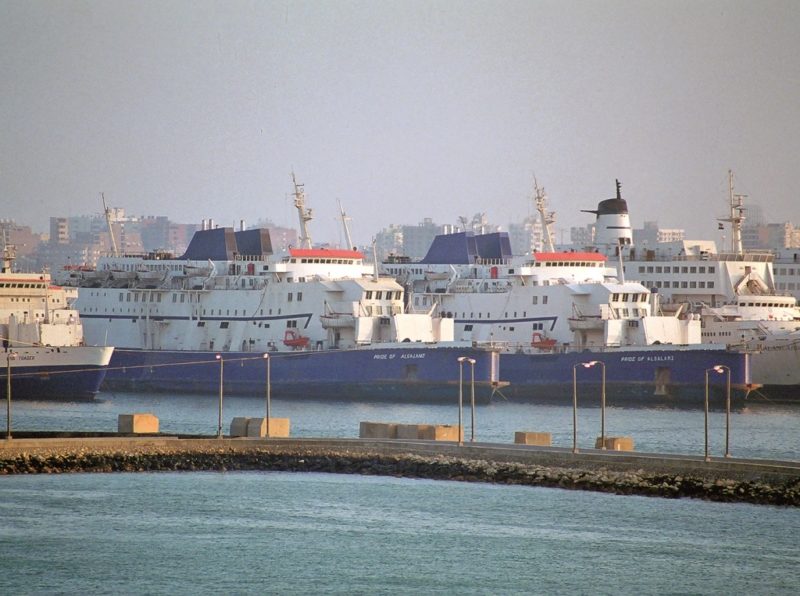
The two companies shared a common philosophy and perhaps most importantly a common source of funds, Hambro’s Bank. In order to fund additional tonnage and squarely meet the competition from the Rail companies at Dover and Southern Ferries at Southampton, a merger, effectively a take-over, was proposed. Following the board’s recommendation Thoresen shareholders readily accepted the parent company offer and Townsend Thoresen was born. The three Vikings and their freight-only fleet mate, Viking IV, were assigned to Thoresen Car Ferries A/S, a Norwegian registered holding company which would charter the ships to a George Nott Industries Ltd. subsidiary trading company, Thoresen Car Ferries Ltd.
Other than a change of funnel livery (a stylised TTF replaced the former motif) and the company name on the flanks there was no material change to the ships’ initial employment. The Free Enterprise ships lost their green hulls which were replaced by the Vikings’ orange and the combined fleet was marketed in a single brochure, under the European Ferries Group name. However an indication of the flexibility inherent within the combined group was evidenced in November 1968 when Viking II provided six weeks cover on the sister company’s Dover-Zeebrugge service.
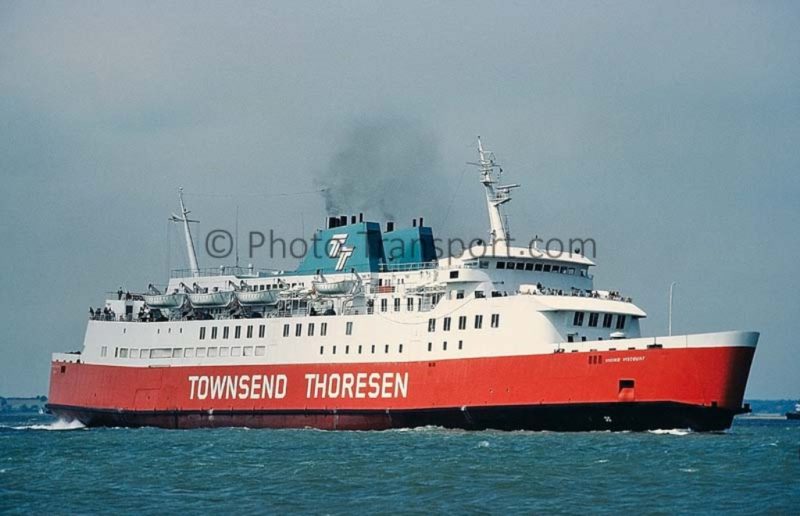
The three Viking ships generally provided reliable and trouble free service but inevitably there were periodic mechanical gremlins and occasional mishaps. The latter included a collision between Viking II and five French fishing boats off Le Havre in early June 1970, one of which was tragically sunk in the encounter. Then there was the weather. Viking III was in the wars when heavy seas in the Channel on 9th December 1965 resulted in the cancellation of the following day’s sailing. Just over a year later, on Christmas Eve 1966, she had to turn back to Bremerhaven whilst on charter to Lion Ferry having encountered a particularly violent North Sea storm. The most serious weather related incident arguably befell Viking I in November 1969, whilst on charter to Silja Line. Plying between the Finnish port of Turku and Stockholm she was buffeted by Force 11 winds and driven ashore which necessitated a dry docking and eleven days of hull repairs in the Swedish capital. Winter charters saw the ships in ports as diverse as Gothenburg and Belfast, Turku and Antwerp but it was a very short term charter that perhaps grabbed the headlines the most. On 12th September 1974 the Compagnie Générale Transatlantique negotiated the use of Viking III to tender marooned passengers and luggage from the company’s liner France, which had been seized by its mutinous crew and anchored in the entry channel to Le Havre.
Viking III was configured differently from her sisters, the forward row of windows on Boat and Promenade Deck betrayed a decision to swap the ’Le Commandant’ restaurant and Cafeteria, the former now enjoying sweeping sea views, whilst the latter now opened out onto the adjacent sun deck. Cabin and sleeperette facilities were also changed, to provide overnight facilities for almost 350 passengers. It was an indication of how Thoresen would constantly upgrade and reconfigure the ships to meet passenger expectations and as a reaction to operational experience. In February 1967 Viking I had additional cabin facilities added aft of the bridge but the most significant refits occurred over the winter of 1969/70. At this time the previously enclosed ‘Smuggler’s Cave’ bar forward on Promenade Deck was rebuilt and made open plan, whilst the popular, adjacent Smorgasbord was reconfigured and renamed ’The Norseman’. Structurally a portion of the aft sundeck on Boat Deck was enclosed to make space for 50 additional sleeperette recliners.
The formation of European Ferries Group inevitably led to investment in new tonnage. With Free Enterprise II supplementing the summer schedules from Southampton it was clear additional capacity was needed. In December 1970 it was announced that five new ships were to be ordered, two Free Enterprise class ones for Dover service and three enlarged ‘Super-Viking’s’ for Southampton. Built at Aalborg Vaerft A/S in Denmark the latter ferries entered service in 1975 and 1976 as Viking Venturer, Viking Valiant and finally Viking Voyager precipitating, it appeared, the withdrawal and sale of the incumbent Vikings. However on 23rd October 1974 Viking II had inaugurated a new, twice daily service between Felixstowe and Zeebrugge and so one of the new ships, Viking Venturer, was earmarked to operate in tandem with her older fleet mate on this route. 1976 was a pivotal year for the UK ferry scene with the opening of a new facility at Portsmouth, the key incentive for shifting operations from Southampton being the more positive labour relations at its Hampshire neighbour. “…..as a gesture to the people of Portsmouth, who have welcomed us so warmly into their city”, Townsend Thoresen Chairman Keith Wickenden presided over a renaming ceremony prior to the company’s inaugural 17th June sailing to Cherbourg, Viking I becoming Viking Victory in honour of Nelson’s famous flagship, prize exhibit at the adjacent Naval Base.
Whilst Viking Victory was plying new ground her sister Viking II was undertaking a first summer season charter between Denmark and Sweden for Lion Ferry. Effectively surplus to Townsend Thoresen’s requirements she was quickly snapped up at the end of the charter by British Rail, through Lloyd’s Leasing, and delivered to the company’s conversion facility at Holyhead on 22nd December. She was earmarked to spearhead a new Sealink service from Portsmouth to the Channel Islands, at the end of what became a long and protracted refit. A full thirteen months after her purchase, resplendent in her new owner’s blue hull with prominent white company name, white superstructure and red funnels, sporting the BR motif, the rechristened Earl William entered service on 16th January 1978. In fact she was joining a near sister in service between the UK and the Islands, the KEH designed, Weymouth based Earl Godwin, whose similar dimensions made her ideal for the tight confines of St. Peter Port and St. Helier harbours.
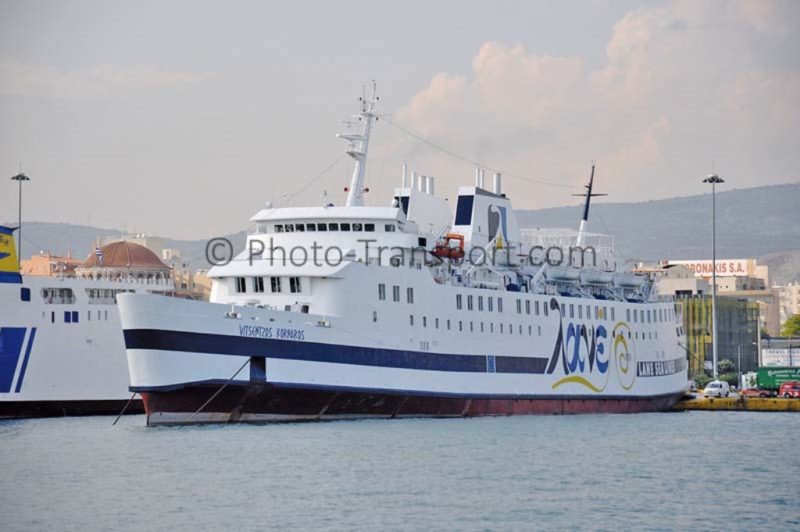
As if unable to be separated, Viking Victory joined the others on charter to Sealink for Channel Island service during April 1978, before resuming her Portsmouth-Cherbourg service over the summer months. The previous month Viking III had inaugurated a new Townsend Thoresen service between Rotterdam and Felixstowe, operating until October when Viking Victory took over, thereby releasing the last of the original Vikings to try a new winter timetable between Kristiansand and Leith. Neither of these services endured, the Scotland to Norway one ending after just one season and the Suffolk to Holland one terminating in September 1979.
Amongst a number of charters in the first few months of the new decade, Viking III found herself standing in for the Earl William in May 1980, whilst the latter underwent repairs to a faulty generator. The last of the trio was very busy that year, spending much of it on the Irish Sea with two spells on Sealink Manx Line’s Heysham-Douglas service bracketing a summer season on B+I Line’s Pembroke Dock to Rosslare service. In 1981, once more surplus to Townsend Thoresen’s plans Viking III spent the summer on charter to Fred. Olsen Line, plying the company’s Kristiansand-Hirtshals service before heading to Gothenburg for an extended lay-up. In the winter she was put on the sales list. She was sold the following year, 1982, to Da-No Linjen, becoming that company’s Terje Vigen on their busy Frederikshavn-Frederikstad itinerary.
Somewhat ironically therefore, the first of the Thoresen Vikings, Viking Victory, was the last to leave the fleet. After a spring charter on the Sealink Manx Line service she maintained her owners Portsmouth-Cherbourg link throughout the summer of 1982, concluding with a 1330 departure from the French port on Monday 13th September. In the forthcoming year Townsend Thoresen would redirect all their South Coast services from Southampton to its great rival along the coast, shifting the newer ’Super Vikings’ to take over Viking Victory’s role. So the pioneering Viking was put up for sale and acquired by the wonderfully named Euphoria Navigation Company, based in Limassol and renamed Sun Boat to operate the equally upbeat sounding ‘Happiness Ferries’ service between Greece and Syria, calling at Rhodes, Cyprus and Lebanon en route.
The Vikings enjoyed long, diverse and interesting, if not always totally successful, ‘after lives’. The most widely travelled was the former Viking I. After barely two years in the Eastern Med she became a Pilgrim carrier in the Red Sea, linking Suez Jeddah and Aqaba as Caravan. The following year, 1986, in a bid to avoid arrest for unpaid debts and briefly renamed Vasmed she circumnavigated the African continent, a remarkable voyage that included bunkering stops at Djibouti, Cape Town and Las Palmas. She was back on the Piraeus-Latakia service as Sunny Boat later that same year, garnering headlines for her role in extricating refugees from war-torn Beirut. For 1990 she moved west, chartered by European Seaways for the Patras-Brindisi tourist service as European Glory. Then in July 1991 she was purchased by Regonti Navigation Company and operated on the same Adriatic route linking Italy and Greece for Hellenic Mediterranean Lines (HML) as Neptunia. The new service was so successful that HML purchased the ship after that first season and renamed her Media II, for a settled decade of operation lasting into the new millennium.
Stepping back to the 1970s, Earl William, the erstwhile Viking II, endured a troubled start to her Channel Island service. Her machinery proved particularly problematic, necessitating expensive and time consuming repairs as well as fleet re-jigs and short term charter cover. There were other mishaps. In January 1979 she became entangled with mooring chains that buckled a prop shaft and badly damaged her propellers. Nevertheless she became a staple part of the Guernsey and Jersey run, initially from Portsmouth and subsequently, after the introduction of the larger Earl Granville, from Weymouth. The year 1981 was something of an annus horribilis for the Earl William and indeed Earl Granville, with more mechanical failures and two groundings limiting her time in service. Privatisation and the ensuing sale to Sea Containers in July 1984 proved calamitous for the service and ship. The acquirer initially considered transferring Earl William to the Mediterranean as the maritime extension of their Orient Express service but instead she and Earl Granville were to be part of a rather bizarre £5 million upgrading of the Channel Island route and a supplementary Cherbourg itinerary, to ‘Bateau de Luxe’ standards, as part of a new overnight ‘Starliner’ service. Following a delayed delivery from her extensive refit at Aalborg (due to Danish strike action) Earl William started the Starliner service on 24th April 1985, the ‘up-market’ product included a buffet dinner, ensuite luxury cabin and full English breakfast. Sea Containers had not only misread the requirements of the Channel Island service but also underestimated the competition. Brittany Ferries, through their Channel Island Ferries subsidiary introduced the Corbière, a sister ship to Earl Granville but with unpretentious facilities and lower fares, better suited to the Islands market. For 1986 Earl William received further investment with an additional motorists lounge built on the original ‘Upper Bridge Deck’ but with the British Ferries share of traffic plummeting and the announcement of a joint service prompting union strike action, she was withdrawn and laid up in the River Fal. She endured a particularly inglorious fall from glory. After serving as an accommodation ship for asylum seekers at Harwich, in which she ran aground during the Great Storm of October 1987, she introduced a new short lived Liverpool-Dun Laoghaire service before a further period of lay-up. In 1990 she deputised on Folkestone-Boulogne and Irish Sea services before moving south for an intended summer Mediterr-anean charter between Tunisia and France. The charterers refused to accept her and she ultimately returned to lay-up at Milford Haven. In April 1992 the rather sorry tale of Earl William’s Sealink career came to an end when she was sold for £1.5 million to the Valetta based Ardonis Shipping Co. who abbreviated her name to William.
The former Viking II spent the rest of the 1990s being passed from pillar to post, under multiple owners primarily on Adriatic service as Pearl William, Mar-Julia and Cesme Stern, before her sale in 2000 to Windward Lines, St. Vincent. She was moved to Trogir, Croatia for a conversion and refit into Windward II, once more bearing an orange hull but destined to stay at the shipyard for three long years.
Overcoming financial problems Viking II’s Caribbean owners finally secured their ship in 2003 and Windward II sailed from Croatia to Port of Spain. Alas her situation did not improve and after a collision with the tanker Nelson she was arrested at the end of January 2004. Released in April the same year she was chartered to the government of Trinidad and Tobago for inter-island service in August and September. Having been laid up in September 2004 in the Gulf of Pania it appeared the end was nigh but a brand new lease of life was around the corner.In 2006 she was acquired by Treasure Queen Tours and sent for a $30 million internal reconstruction in preparation for a new role as a hotel and convention venue. On 1st September 2007 the renamed Ocean Pearl opened her stern ramp, which had been converted into the main entrance, to customers. With her engines stripped out and interiors gutted the former Viking II now sported ‘The Aurora’ conference hall, luxury cabins in the ‘Treasures Floatel‘, and the ‘High Tide’ seafood and steakhouse indoor/outdoor restaurant offering the somewhat dubious novelty ‘lifeboat’ dining venue. The ‘Seacrets Ocean Bar and Lounge’ became a favourite venue for evening cocktails. She was moored with her stern attached to a specially constructed, palm lined pontoon at Williams Bay, Chaguaramus, Trinidad & Tobago.
The Ocean Pearl venture lasted a while but three and a half years later, devoid of power, the ship was involved in a bizarre incident whilst under tow to Venezuela. On nd April 2011 the tug Icon 1 struck a drilling rig dragging the former Viking II along which then collided with the rig‘s mooring chains. The tug slipped its tow as the former ferry took on water, drifted and sank a short while later.
Bucking the trend for superannuated UK ferries, Viking III spent most of her post-Townsend Thoresen career in the Baltic Sea, rather than migrating south to a warm and relatively tranquil retirement in the Eastern Mediterranean. Having spent four years as Terje Vigen linking Denmark and Norway she was purchased by Rederi Narko A/S in 1986 and chartered as Scandinavia to the Finnish KG Line for their Gavle-Kaskinen route. In 1990 Hango Line of Finland acquired her but promptly sold her on to Europe Cruise Line A/S, the first in a succession of Norwegian owners, for Baltic and latterly Oslofjord service. The ship seemed destined for a dramatic finale in October 2000 when sold to Buquebus Los Ciprese SA of Montevideo and was scheduled to sail south to Uruguay for service across the River Plate, akin to the route envisaged by Otto Thoresen almost forty years earlier. However it wasn’t to be.
Having already exceeded the lifespan of many of their peers the former Vikings endured well into the millennium, in body if not necessarily in spirit. The last of the class is still with us.
Viking I’s successful stint on HML’s Italy-Greece service lasted until March 2002 when she was sold to Palmier Ferries, an Italian operation that modified her name to Media V. The following year she started a Brindisi-Vlore (Albania) route, despite a bright new yellow hulled livery the Thoresen’s cross-Channel trailblazer was now on the lowest rung of the Mediterranean ferry scene. The ship was arrested for unpaid debts twice in subsequent years, as she languished in one lay-up berth after another before finally going for scrap in 2008.

Viking III’s aborted move to South America was followed by three years of inactivity and then a series of unsuccessful attempts to revive her fortunes in and around Scandinavian waters. In March 2007 she finally left Norway for Perama and then Brindisi, to be refitted for the Brindisi-Vlore (Albania) route that her oldest sister had earlier frequented. Under the ownership of North Bay Transportes Maritimos Ltd. she entered service as Red Star 1 in August the same year for Star ferries. In 2011 Red Star 1 undertook a number of humanitarian voyages to evacuate refugees from the Libyan civil war and the following year operated a Bari-Durres service before reverting to her original Brindisi-Vlore connection in 2013. Presently she is laid up at Piraeus but with the Covid-19 pandemic and economic aftermath drastically affecting all shipping activities, it can surely only be a matter of time before this 55 year old veteran finally rings up “finished with engines”.
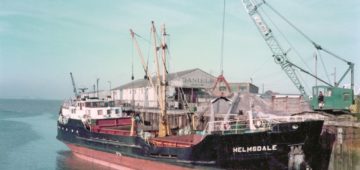



Comments
Sorry, comments are closed for this item